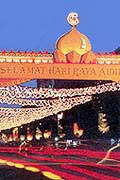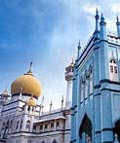|
|
|
 |
Popular
Places |
Geylang
Serai
 The
Malays had been living in Singapore long before any of the other races.
Geylang became their enclave in the 1840s after the British dispersed
the Malay-floating village at the mouth of Singapore River. Together with
the large influx of Malaysians and Indonesians, many wealthy Arabs then
congregated in Geylang. Malay influence is still strong in Geylang Serai
as reflected in the restaurants and shops specializing in Malay cuisine,
ethnic goods, and art and crafts. In the heart of Geylang Serai is the
Malay Village, a vibrant cultural showcase of the Malay community. Spectacular
entertainment and live shows await the curious visitor. This includes
Lagenda Fantasi, a unique 25-minute multi-sensory presentation on ancient
Arabian Nights' folklore. Kampong Days, a walk-through showcase, depicts
the traditional lifestyle of Malays in the 1950s and 60s. You can also
experience traditional Malay art and crafts like batik painting, kite-making,
and kampong (village) games such as top spinning. Other highlights in
Geylang Serai include the Geylang Serai Market, the Chinese Baroque terrace
houses, and the Malay bungalows complete with woodcarvings and European
tiles. The
Malays had been living in Singapore long before any of the other races.
Geylang became their enclave in the 1840s after the British dispersed
the Malay-floating village at the mouth of Singapore River. Together with
the large influx of Malaysians and Indonesians, many wealthy Arabs then
congregated in Geylang. Malay influence is still strong in Geylang Serai
as reflected in the restaurants and shops specializing in Malay cuisine,
ethnic goods, and art and crafts. In the heart of Geylang Serai is the
Malay Village, a vibrant cultural showcase of the Malay community. Spectacular
entertainment and live shows await the curious visitor. This includes
Lagenda Fantasi, a unique 25-minute multi-sensory presentation on ancient
Arabian Nights' folklore. Kampong Days, a walk-through showcase, depicts
the traditional lifestyle of Malays in the 1950s and 60s. You can also
experience traditional Malay art and crafts like batik painting, kite-making,
and kampong (village) games such as top spinning. Other highlights in
Geylang Serai include the Geylang Serai Market, the Chinese Baroque terrace
houses, and the Malay bungalows complete with woodcarvings and European
tiles.
Getting
there :
Walk towards Geylang Road from Payar Lebar MRT Station.
Kampong
Glam
 The
name Kampong Glam comes from the Glam tree, which grew in the area. Medicinal
oil was extracted from the tree and the Buginese and Malays used its bark
to caulk their ships. Kampong Glam was the historic seat of the Malay
royalty in Singapore. It was originally a fishing village at the mouth
of the Rochor River. Today, the area sits between new terrace houses and
old shophouses. Highlights of Kampong Glam include the Sultan Mosque,
the biggest mosque in Singapore with the capacity to accommodate up to
5,000 Muslims in congregational prayers. Other highlights include the
old Malay Cemetery and Rumah Panjang. Also, look out for the Arab cloth
merchants with their delicate silks and velvets, as well as food stores
selling traditional Arab-Muslim foodstuff and merchandise of all kinds. The
name Kampong Glam comes from the Glam tree, which grew in the area. Medicinal
oil was extracted from the tree and the Buginese and Malays used its bark
to caulk their ships. Kampong Glam was the historic seat of the Malay
royalty in Singapore. It was originally a fishing village at the mouth
of the Rochor River. Today, the area sits between new terrace houses and
old shophouses. Highlights of Kampong Glam include the Sultan Mosque,
the biggest mosque in Singapore with the capacity to accommodate up to
5,000 Muslims in congregational prayers. Other highlights include the
old Malay Cemetery and Rumah Panjang. Also, look out for the Arab cloth
merchants with their delicate silks and velvets, as well as food stores
selling traditional Arab-Muslim foodstuff and merchandise of all kinds.
Getting
there :
Walk toward Arab Street from Bugis MRT Station.
Top
of Page
|
